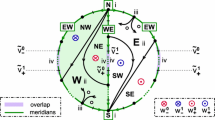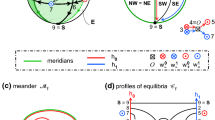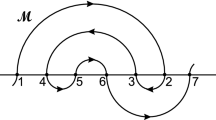Abstract
This is the second of three papers on the geometric and combinatorial characterization of global Sturm attractors which consist of a single closed 3-ball. The underlying scalar PDE is parabolic,
on the unit interval \(0< x<1\) with Neumann boundary conditions. Equilibria are assumed to be hyperbolic. Geometrically, we study the resulting Thom–Smale dynamic complex with cells defined by the unstable manifolds of the equilibria. The Thom–Smale complex turns out to be a regular cell complex. Our geometric description is slightly more refined. It involves a bipolar orientation of the 1-skeleton, a hemisphere decomposition of the boundary 2-sphere by two polar meridians, and a meridian overlap of certain 2-cell faces in opposite hemispheres. The combinatorial description is in terms of the Sturm permutation, alias the meander properties, of the shooting curve for the equilibrium ODE boundary value problem. It involves the relative positioning of extreme 2-dimensionally unstable equilibria at the Neumann boundaries \(x=0\) and \(x=1\), respectively, and the overlapping reach of polar serpents in the shooting meander. In the first paper we showed the implications
The present part 2 closes the cycle of equivalences by the implication
In particular this cycle allows us to construct a unique Sturm 3-ball attractor for any prescribed Thom–Smale complex which satisfies the geometric properties of the bipolar orientation and the hemisphere decomposition. Many explicit examples and illustrations will be discussed in part 3. The present 3-ball trilogy, however, is just another step towards a still elusive geometric and combinational characterization of all Sturm global attractors in arbitrary dimensions.












Similar content being viewed by others
References
Angenent, S.: The Morse–Smale property for a semi-linear parabolic equation. J. Differ. Equ. 62, 427–442 (1986)
Angenent, S.: The zero set of a solution of a parabolic equation. J. Reine Angew. Math. 390, 79–96 (1988)
Arnold, V.I.: A branched covering \(\mathit{CP}^2 \rightarrow S^4\), hyperbolicity and projective topology. Sib. Math. J. 29, 717–726 (1988)
Arnold, V.I., Vishik, M.I., et al.: Some solved and unsolved problems in the theory of differential equations and mathematical physics. Russ. Math. Surv. 44, 157–171 (1989)
Babin, A.V., Vishik, M.I.: Attractors of Evolution Equations. North Holland, Amsterdam (1992)
Bismut, J.-M., Zhang,W.: An Extension of a Theorem by Cheeger and Müller. With an Appendix by François Laudenbach. Astérisque, 205. Société Mathématique de France, Paris (1992)
Bott, R.: Morse theory indomitable. Public. Math. I.H.É.S. 68, 99–114 (1988)
Brunovský, P.: The attractor of the scalar reaction diffusion equation is a smooth graph. J. Dyn. Differ. Equ. 2, 293–323 (1990)
Brunovský, P., Fiedler, B.: Numbers of zeros on invariant manifolds in reaction–diffusion equations. Nonlinear Anal. TMA 10, 179–193 (1986)
Brunovský, P., Fiedler, B.: Connecting orbits in scalar reaction diffusion equations. Dyn. Rep. 1, 57–89 (1988)
Brunovský, P., Fiedler, B.: Connecting orbits in scalar reaction diffusion equations II: the complete solution. J. Differ. Equ. 81, 106–135 (1989)
Chepyzhov, V.V., Vishik, M.I.: Attractors for Equations of Mathematical Physics. Colloq. AMS, Providence (2002)
Eden, A., Foias, C., Nicolaenko, B., Temam, R.: Exponential Attractors for Dissipative Evolution Equations. Wiley, Chichester (1994)
Fiedler, B., Grotta-Ragazzo, C., Rocha, C.: An explicit Lyapunov function for reflection symmetric parabolic differential equations on the circle. Russ. Math. Surveys. 69, 419–433 (2014)
Fiedler, B., Rocha, C.: Heteroclinic orbits of semilinear parabolic equations. J. Differ. Equ. 125, 239–281 (1996)
Fiedler, B., Rocha, C.: Realization of meander permutations by boundary value problems. J. Differ. Equ. 156, 282–308 (1999)
Fiedler, B., Rocha, C.: Orbit equivalence of global attractors of semilinear parabolic differential equations. Trans. Am. Math. Soc. 352, 257–284 (2000)
Fiedler, B., Rocha, C.: Connectivity and design of planar global attractors of Sturm type, II: connection graphs. J. Differ. Equ. 244, 1255–1286 (2008)
Fiedler, B., Rocha, C.: Connectivity and design of planar global attractors of Sturm type, I: bipolar orientations and Hamiltonian paths. J. Reine Angew. Math. 635, 71–96 (2009)
Fiedler, B., Rocha, C.: Connectivity and design of planar global attractors of Sturm type, III: small and platonic examples. J. Dyn. Differ. Equ. 22, 121–162 (2010)
Fiedler, B., Rocha, C.: Nonlinear Sturm global attractors: unstable manifold decompositions as regular CW-complexes. Discrete Contin. Dyn. Syst. 34, 5099–5122 (2014)
Fiedler, B., Rocha, C.: Schoenflies spheres as boundaries of bounded unstable manifolds in gradient Sturm systems. J. Dyn. Differ. Equ. 27, 597–626 (2015)
Fiedler, B., Rocha, C.: Sturm 3-balls and global attractors 1: Thom-Smale complexes and meanders. arXiv:1611.02003 (2016); São Paulo J. Math. Sci. (2017). https://doi.org/10.1007/s40863-017-0082-8
Fiedler, B., Rocha, C.: Sturm 3-balls and global attractors 3: Examples of Thom-Smale complexes. Discrete Contin. Dyn. Syst. A 38, 3479–3545 (2018). https://doi.org/10.3934/dcds.2018149
Fiedler, B., Scheel, A.: Spatio-temporal dynamics of reaction–diffusion patterns. In: Kirkilionis, M., et al. (eds.) Trends in Nonlinear Analysis, pp. 23–152. Springer, Berlin (2003)
Franks, J.M.: Morse–Smale flows and homotopy theory. Topology 18, 199–215 (1979)
Fritsch, R., Piccinini, R.A.: Cellular Structures in Topology. Cambridge University Press, Cambridge (1990)
Fusco, G., Oliva, W.: Jacobi matrices and transversality. Proc. R. Soc. Edinb. A 109, 231–243 (1988)
Fusco, G., Rocha, C.: A permutation related to the dynamics of a scalar parabolic PDE. J. Differ. Equ. 91, 75–94 (1991)
Galaktionov, V.A.: Geometric Sturmian Theory of Nonlinear Parabolic Equations and Applications. Chapman & Hall, Boca Raton (2004)
Hale, J.K.: Asymptotic Behavior of Dissipative Systems. Mathematical Surveys and Monographs, vol. 25. American Mathematical Society, Providence (1988)
Hale, J.K., Magalhães, L.T., Oliva, W.M.: Dynamics in Infinite Dimensions. Springer, New York (2002)
Henry, D.: Geometric Theory of Semilinear Parabolic Equations. Lecture Notes in Mathematics, vol. 804. Springer, New York (1981)
Henry, D.: Some infinite dimensional Morse–Smale systems defined by parabolic differential equations. J. Differ. Equ. 59, 165–205 (1985)
Hu, B.: Blow-up Theories for Semilinear Parabolic Equations. Lecture Notes in Mathematics, vol. 2018. Springer, Berlin (2011)
Jolly, M.S.: Explicit construction of an inertial manifold for a reaction diffusion equation. J. Differ. Equ. 78, 220–261 (1989)
Ladyzhenskaya, O.A.: Attractors for Semigroups and Evolution Equations. Cambridge University Press, Cambridge (1991)
Lappicy, Ph., Fiedler, B.: A Lyapunov function for fully nonlinear parabolic equations in one spatial variable. arxiv:1802.09754 [math.DS]. Submitted (2018)
Matano, H.: Convergence of solutions of one-dimensional semilinear parabolic equations. J. Math. Kyoto Univ. 18, 221–227 (1978)
Matano, H.: Nonincrease of the lap-number of a solution for a one-dimensional semi-linear parabolic equation. J. Fac. Sci. Univ. Tokyo Sec. IA 29, 401–441 (1982)
Matano, H., Nakamura, K.-I.: The global attractor of semilinear parabolic equations on \({S^1}\). Discrete Contin. Dyn. Syst. 3, 1–24 (1997)
Mallet-Paret, J.: Morse decompositions for delay-differential equations. J. Differ. Equ. 72, 270–315 (1988)
Palis, J., de Melo, W.: Geometric Theory of Dynamical Systems. An Introduction. Springer, New York (1982)
Palis, J., Smale, S.: Structural stability theorems. Global Analysis. In: Proceedings of Simposia in Pure Mathematics AMS, Providence (1970)
Pazy, A.: Semigroups of Linear Operators and Applications to Partial Differential Equations. Springer, New York (1983)
Raugel, G.: Global attractors in partial differential equations. In: Fiedler, B. (ed.) Handbook of Dynamical Systems, vol. 2, pp. 885–982. Elsevier, Amsterdam (2002)
Rocha, C.: Properties of the attractor of a scalar parabolic PDE. J. Dyn. Differ. Equ. 3, 575–591 (1991)
Sell, G.R., You, Y.: Dynamics of Evolutionary Equations. Springer, New York (2002)
Sturm, C.: Sur une classe d’équations à différences partielles. J. Math. Pure Appl. 1, 373–444 (1836)
Tanabe, H.: Equations of Evolution. Pitman, Boston (1979)
Temam, R.: Infinite-Dimensional Dynamical Systems in Mechanics and Physics. Springer, New York (1988)
Wolfrum, M.: Geometry of heteroclinic cascades in scalar parabolic differential equations. J. Dyn. Differ. Equ. 14, 207–241 (2002)
Zelenyak, T.I.: Stabilization of solutions of boundary value problems for a second order parabolic equation with one space variable. Differ. Equ. 4, 17–22 (1968)
Acknowledgements
We are deeply indebted to George Sell who has encouraged and inspired our work on global attractors for decades. Extended delightful hospitality by the authors is mutually acknowledged. Suggestions concerning the Thom–Smale complex were generously provided by Jean-Michel Bismut. Gustavo Granja has generously shared his deeply topological view point, precise references included. Anna Karnauhova has contributed all illustrations with great patience, ambition, and her inimitable artistic touch. Typesetting was expertly accomplished by Ulrike Geiger. This work was partially supported by DFG/Germany through SFB 910 Project A4 and by FCT/Portugal through Project UID/MAT/04459/2013.
Author information
Authors and Affiliations
Corresponding author
Additional information
In memoriam George R. Sell, mentor and friend.
Appendix: Wolfrum’s Lemma
Appendix: Wolfrum’s Lemma
In this technical Appendix we comment on, and repair, a gap in the original proof of Wolfrum’s Lemma 5.2.
In [52, theorem 2.1] the lemma has first been formulated in the present form. The gap in the proof arises, formally, by an overinterpretation of realization results in [16] to provide templates for arbitrary sequences of saddle-node bifurcations. This is not quite what we had proved there. The relevant result is [16, lemma 3.1]. Already in the simplest case it is based, first, on a “short arc” nose retraction, via a saddle-node bifurcation. Second, the resulting nose in the meander \(\mathcal {M}\) has to be retracted counterclockwise towards the lower, reduced, number of equilibria. See [16, fig. 3]. This brings the relevant Sturm shooting meanders \(\mathcal {M}\) into canonical form, as specified in [16]. The counterclockwise retraction in the second step has not been addressed in [52].
In fact, the results in [16] do allow a nose removal by a saddle-node bifurcation which pushes its “short arc” of \(\mathcal {M}\) nearly vertically through the horizontal axis. This addresses the first step, locally. Neither before, nor after, such a local sadlle-node bifurcation, however, would the resulting meander be in canonical form, globally.
Therefore it remains crucial to lift the clockwise restriction in the second step, towards canonical meanders. We use the global rigidity of Sturm attractors proved in [17]: global Sturm attractors \(\mathcal {A}_f\) and \(\mathcal {A}_g\) with identical Sturm permutations \(\sigma _f = \sigma _g\) are \(C^0\) orbit equivalent. In view of that global rigidity, the Sturm permutations on either side of the local saddle-node bifurcation can therefore be realized by shooting curves, again, which are canonical meanders. As a caveat we add that it is still unknown to us whether that second step can be achieved by a global parameter homotopy of Sturm nonlinearities f, within the PDE class (1.1). Instead, the rigidity proof in [17] used a discretization, and subsequent dimensional augmentation, to provide parameter homotopies in the potentially much wider ODE class of finite-dimensional Jacobi systems. At any rate, this remark remedies both gaps in the proof of [52, theorem 2.1].
The proof of Wolfrum’s lemma is independent of an earlier Conley index argument in [15] which led to a weaker result. See [52, remark 4.1]. Above we have indicated how arguments of [16, 17] enter, instead.
Rights and permissions
About this article
Cite this article
Fiedler, B., Rocha, C. Sturm 3-Ball Global Attractors 2: Design of Thom–Smale Complexes. J Dyn Diff Equat 31, 1549–1590 (2019). https://doi.org/10.1007/s10884-018-9665-z
Received:
Published:
Issue Date:
DOI: https://doi.org/10.1007/s10884-018-9665-z
Keywords
- Parabolic partial differential equation
- Nodal property
- Global attractor
- Regular cell complex
- Bipolar graph
- Hamiltonian path




